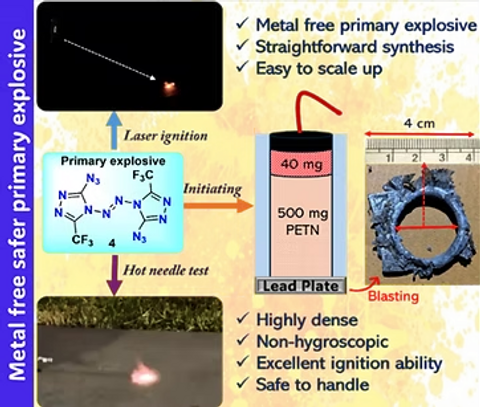
Dr. Abhishek Kumar Yadav
Energetic Materials Researcher
Dr. Abhishek Kumar Yadav is a dedicated Energetic Materials Researcher specializing in the design and synthesis of nitrogen-rich high-energy-density materials. He completed his Ph.D. at IIT Kanpur in 2024 and is currently a Postdoctoral Fellow at the University of Idaho, United States. With 23 peer-reviewed publications and seven Indian patents, his research contributes to advancements in high-performance and environmentally friendly explosives.
Some Selected Publications

Published: April 07, 2025 | Updated: April 12, 2025
In this study, we successfully synthesized and characterized 2-nitroethene-1,1-diyl)bis(hydrazine) (2) in a single step with high yield. Its dual functionality was evaluated as both a hypergolic fuel with WFNA and a secondary explosive comparable to RDX. Offering a safer alternative to H-FOX, it exhibits a decomposition temperature of 160 °C, density 1.60 g cm-³, detonation velocity 8548 m s-1, and specific impulse 220 s, with excellent insensitivity to impact and friction, making it a promising candidate for hybrid propulsion and energetic materials.

Published: Jan 23, 2025 | Updated: Jan 24, 2025
A primary explosive is a perfect chemical compound for starting ignition in military and commercial uses. Over the past century, the quest for lead-free, environmentally friendly primary explosives has been a significant challenge and a long-standing goal. Here, an innovative organic primary explosive, (E)-1,2-bis(3-azido-5-(trifluoromethyl)-4H-1,2,4-triazol-4-yl)diazene (4), has been designed and synthesized through a straightforward three-step reaction from commercially available reagents. Importantly, this compound integrated two trifluoromethyl and azido groups into the N,N′-azo-1,2,4-triazole backbone to enhance the performance and safety. With this combination, it meets stringent criteria for safer, environmentally friendly primary explosives: being metal and perchlorate-free, possessing high density, excellent priming ability, and unique sensitivities to nonexplosive stimuli. It shows robust environmental resistance, good thermal stability, and effective detonation performance and also can be effectively initiated with a laser. Moreover, in the detonation test, compound 4 successfully detonated 500 mg of PETN with an ultralow minimum primer charge (MPC) of 40 mg, similar to traditional primary explosive LA (MPC: 40 mg) and outperforming organic metal-free primary explosives ICM-103 (MPC: 60 mg) and DDNP (MPC: 70 mg). The high detonation power, combined with its straightforward synthesis, cost-effectiveness, and easy large-scale manufacturing, makes it a superior alternative to currently used primary explosives such as lead azide (LA) and diazodinitrophenol (DDNP).

